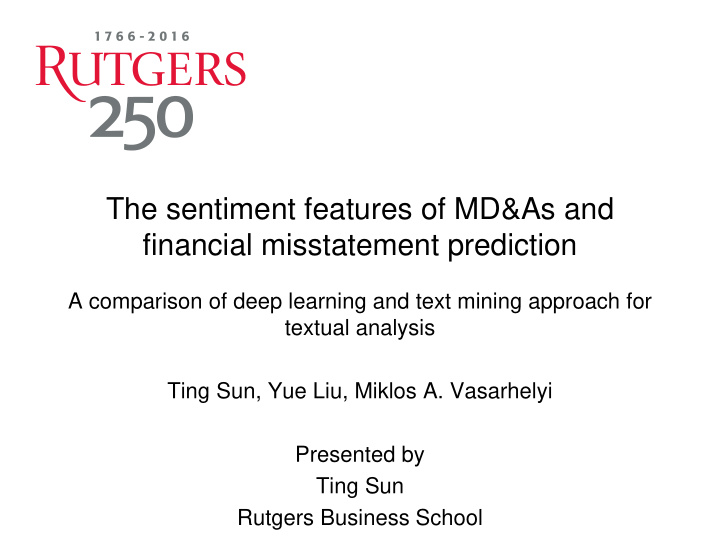



The sentiment features of MD&As and financial misstatement prediction A comparison of deep learning and text mining approach for textual analysis Ting Sun, Yue Liu, Miklos A. Vasarhelyi Presented by Ting Sun Rutgers Business School
Motivations • Deep learning is able to effectively and automatically extract features from data, especially the unstructured or semi- structured data such as videos, audios, and text. • It has achieved great success in speech recognition, object(face) recognition, and textual analysis. • With deep learning approach, the sentiment features of the text can be extracted without human intervention • Few prior literature has applied deep learning based textual analysis approach to auditing
Objective • Demonstrate that deep learning technology can be applied to analyze finance-related text document to obtain the sentiment feature, which is an additional attribute to support audit judgement • Provide evidence for the effectiveness of the sentiment features obtained by deep learning by comparing its prediction power to that of the sentiment features obtained by “bag of words”.
Research Questions (1) Does the sentiment (2) How effective does feature of 10-K the deep learning MD&As extracted by approach perform as compared to “bag of deep learning words” approach in approach provide essential information terms of prediction for financial accuracy? misstatement prediction?
What we did… • We analyzed 30,239 MD&As of 10-K filings for fiscal years from 2006 to 2015 using deep learning and “bag of words” approach and obtained two sets of sentiment scores, Sentiment_DL and Sentiment_TM, respectively. • Utilizing CHAID (CHI-square Adjusted Interaction Detection) algorithm, we established two classification models and compared their predictive performance. • The results showed that both model 1 and model 2 performed better than previous prediction models for the financial misstatement. • The sentiment feature extracted by Deep Learning approach generally performed as effectively as that obtained by “bag of words” approach.
Financial misstatement prediction Prior literature for FM prediction Distinguish financial misstatement The misstatement literature, specifically (FM) from fraud: those related to prediction with Machine FM: annual reports which contain Learning algorithms is limited as compared to fraud. misstatement and have been There is even less research involving content restated. features of text (like sentiment): Cecchini, Fraud: An accounting 2005; Larcker and Zakolyukina, 2012 misstatement is fraudulent if the sample size is relative small and the predictive performance is modest committed with intention. larcker and Zakolyukina, 2012: best AUC=0.597, total sample size=17,150 FM can be seen as a superset of Cecchini, 2005: accuracy=55.84% ,total sample size=800 fraud. It is harder to predict than fraud
Sentiment analysis approaches Deep learning approach Bag of words approach Description of the Emerging technique employing deep Prevalent technique using various pre- technique hierarchical neural network and trained with defined word lists, with each one a large amount of text files representing a particular sentiment feature “understand” the meaning of a text file Rationale count the frequency of the words originated from a specific dictionary Output sentiment Sentiment scores: Sentiment_DL sentiment scores: Sentiment_TX feature Is there prior No Yes literature in accounting and auditing domain Tool Alchemy language API Loughran and McDonald (2011) Is it a finance-specific No Yes tool Required text HTML/text document and webpage HTML/text document document Does it need data No Yes preprocessing
Sample
Distribution of misstatements over fiscal years
Sentiment scores Obs. Min 25% percentile Median 75% percentile Max Sentiment_DL 30239 -.5606 -.0289 .0170 .0658 .7487 Sentiment_TM 30239 -.0721 -.0105 -.0062 -.0024 .0307
Classification models Model 1 Model 2 Dependent Misstatement Misstatement variable Independent Sentiment SENTIMENT_TM SENTIMENT_DL variables measures Other 35 variables 35 variables predictors related to related to following prior misstatement misstatement research
Prediction results of testing data Model 1 Model 2 Accuracy 64.23% 65.7% Type 1 error rate 35.54% 33.32% Type 2 error rate 37.24% 40.66% Precision 0.2139 0.2168 Sensitivity 0.6276 0.5934 specificity 0.6446 0.6668 F1 score 0.3191 0.3176 AUC 0.68 0.68
Conclusions The results show that (1) the sentiment features generated by both approaches exhibit relatively high predictive accuracy in the two prediction models as compared with prior literature of similar sample size; (2) With deep learning approach, we are less likely to have type one errors (3) With “bag of words” approach, we are less likely to have type two errors. Possible reason is that it is a finance-specific approach. (4) Generally speaking, deep learning approach performs as effectively as “bag of words” approach
Recommend
More recommend